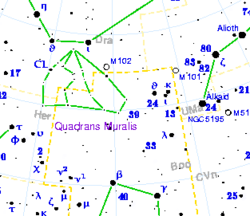CL Draconis is a single[10] star in the northern circumpolar constellation of Draco. It can be viewed with the naked eye, having an apparent visual magnitude of 4.96.[2] The distance to this star, as determined from its annual parallax shift of 29.9 mas,[1] is 109 light years. It is moving closer to the Earth with a heliocentric radial velocity of −11 km/s.[5] The star has a relatively high proper motion, traversing the celestial sphere at the rate of 0.185″/yr.[11]
CL Draconis (circled), with the obsolete constellation Quadrans Muralis in the background. | |
| Observation data Epoch J2000 Equinox J2000 | |
|---|---|
| Constellation | Draco |
| Right ascension | 15h 57m 47.44180s[1] |
| Declination | +54° 44′ 59.1428″[1] |
| Apparent magnitude (V) | 4.96[2] |
| Characteristics | |
| Spectral type | F0 IV[3] |
| B−V color index | 0.269±0.008[2] |
| Variable type | δ Sct[4] |
| Astrometry | |
| Radial velocity (Rv) | −11.0±4.2[5] km/s |
| Proper motion (μ) | RA: −151.643[1] mas/yr Dec.: +107.519[1] mas/yr |
| Parallax (π) | 29.9305 ± 0.1368 mas[1] |
| Distance | 109.0 ± 0.5 ly (33.4 ± 0.2 pc) |
| Absolute magnitude (MV) | 2.33[2] |
| Details | |
| Mass | 1.68±0.01[6] M☉ |
| Luminosity | 10.2+0.2 −0.3[6] L☉ |
| Surface gravity (log g) | 4.04±0.14[7] cgs |
| Temperature | 7,439±253[7] K |
| Metallicity [Fe/H] | 0.04±0.10[8] dex |
| Rotational velocity (v sin i) | 165[6] km/s |
| Age | 643[7] Myr |
| Other designations | |
| Database references | |
| SIMBAD | data |
Based upon a stellar classification of F0 IV,[3] this is an aging F-type subgiant star that has consumed the hydrogen at its core. It is spinning rapidly with a projected rotational velocity of 165 km/s,[6] giving it an oblate shape with an equatorial bulge that is estimated to be 8% larger than the polar radius.[12]

CL Draconis is a Delta Scuti variable, changing brightness with an amplitude of 0.010 magnitude over a period of 1.83 hours.[14] CL Dra has 1.68[6] times the mass of the Sun and is radiating 10.2[6] times the Sun's luminosity from its photosphere at an effective temperature of 7,439 K.[7]
It was transferred from Draco to Quadrans Muralis. Later when the International Astronomical Union officially recognised constellations, Quadrans Muralis became obsolete, so this star was moved back to Draco.
